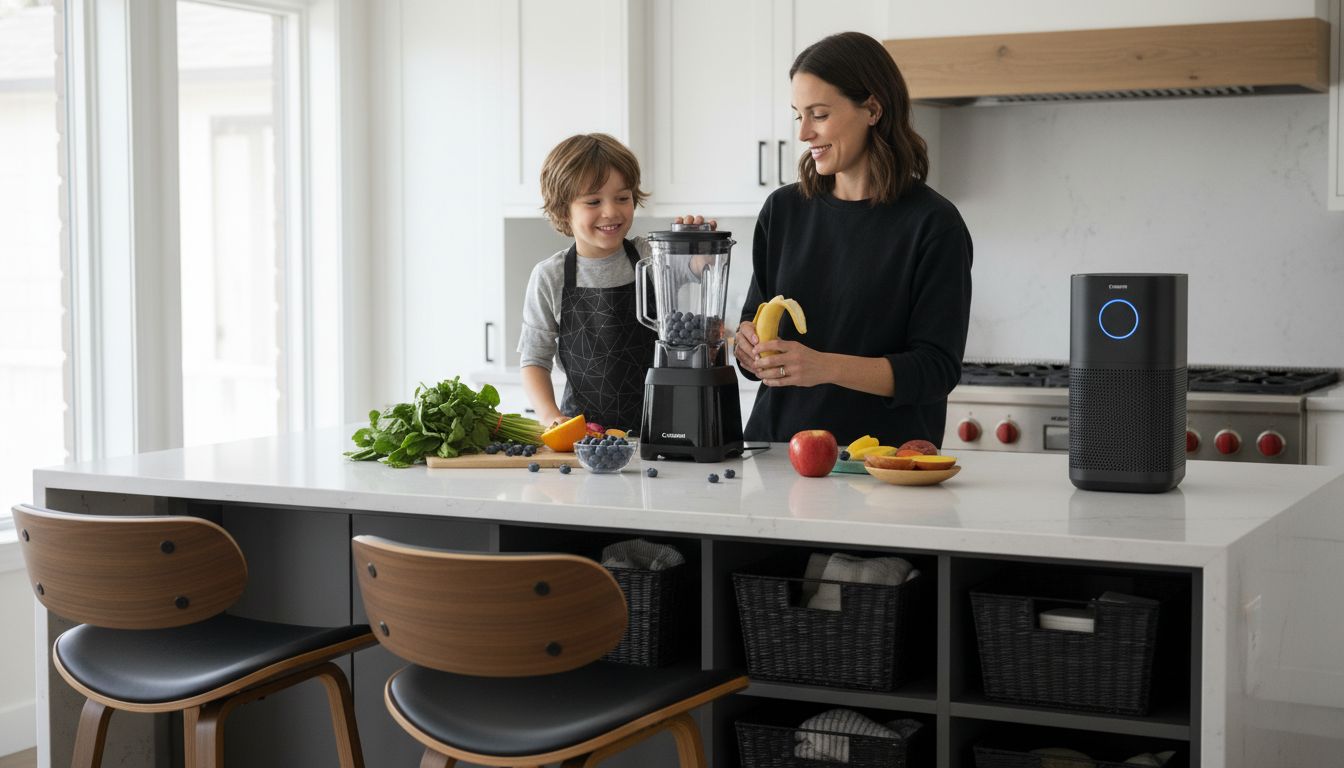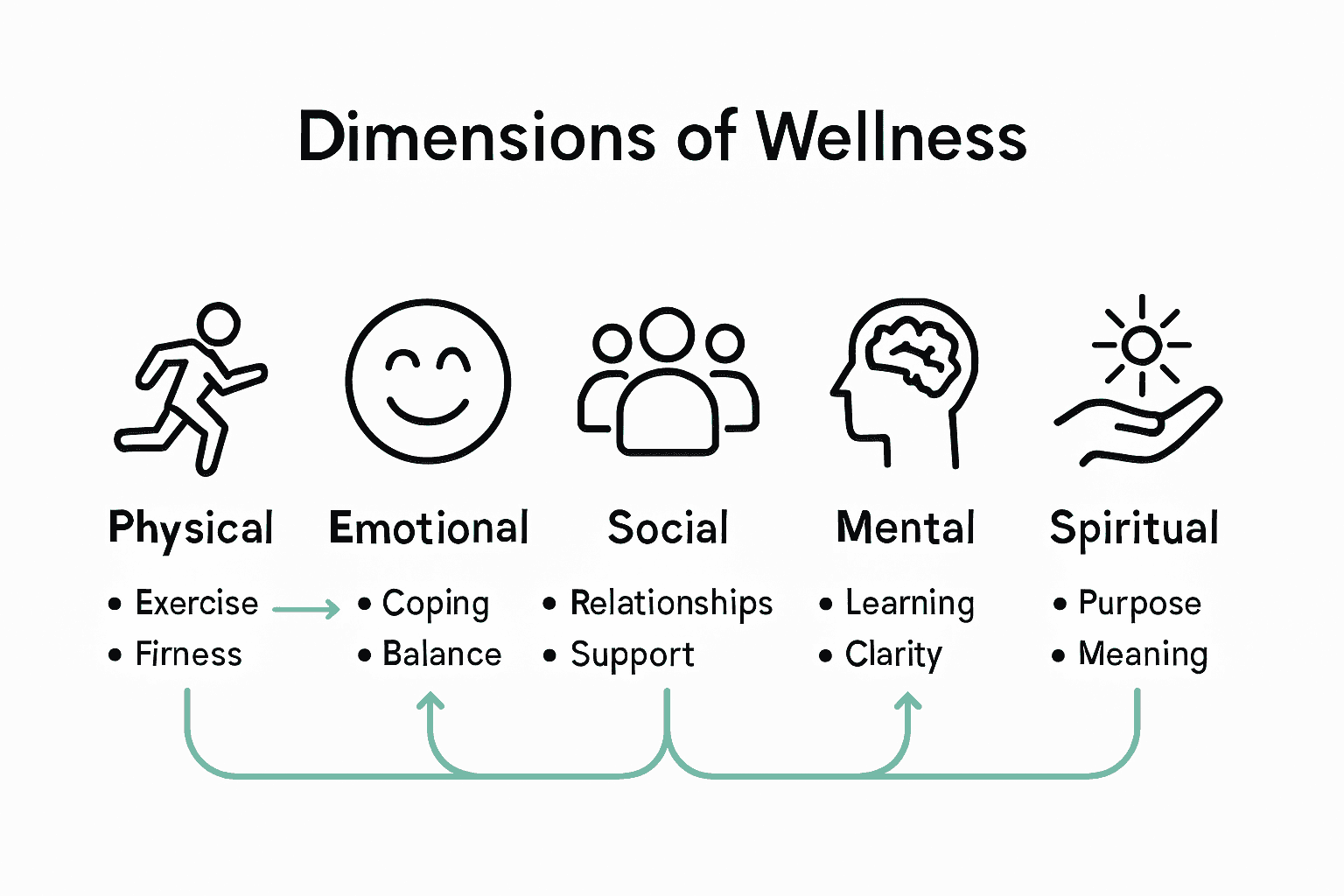
Nearly 90 percent of people say their surroundings have a direct impact on their well-being. How you design and care for your home shapes your mood, energy, and even your long-term health. Creating a space that supports both body and mind is more than a trend, it is a daily investment in your quality of life. Learn how practical choices and small changes at home can spark major shifts in wellness.
Table of Contents
- Defining Wellness at Home Concepts
- Types of Home Wellness Practices
- Key Elements for a Healthy Environment
- Role of Organization in Home Wellness
- Benefits and Common Challenges to Expect
Key Takeaways
| Point | Details |
|---|---|
| Holistic Approach | Wellness at home integrates physical, mental, emotional, and social dimensions, requiring intentional choices for well-being. |
| Key Dimensions | Focus on creating supportive environments through physical comfort, emotional sanctuary, and social connectivity enhances overall health. |
| Health Practices | Essential practices for home wellness include exercise, stress management, and mindfulness, promoting a balanced lifestyle. |
| Organizational Importance | Effective home organization reduces clutter and stress while supporting personalized wellness goals through functional spaces. |
Defining Wellness at Home Concepts
Wellness at home represents a holistic approach to creating an environment that nurtures physical, mental, and emotional well-being. According to research from PubMed, wellness is a dynamic process involving healthy habits, conscientiousness, and an optimal state of health that extends far beyond simple physical fitness.
At its core, wellness is a deliberate, conscious process requiring individuals to become aware of and make intentional choices for a more satisfying lifestyle. As insights from SO02 suggest, this approach encompasses comprehensive care of the mind, body, and soul while being deeply influenced by personal culture and life experiences.
Key dimensions of home wellness include:
- Physical Environment: Creating spaces that promote relaxation and comfort
- Mental Health: Designing areas that reduce stress and support emotional balance
- Personal Habits: Establishing routines that encourage self-care and personal growth
- Emotional Sanctuary: Crafting living spaces that feel safe, nurturing, and restorative
For those seeking to enhance their home wellness journey, work life balance tips guide can provide additional strategies for creating a harmonious living environment that supports overall well-being.
Types of Home Wellness Practices
Wellness practices encompass a holistic approach to personal health, addressing multiple dimensions of well-being. According to research from ISBE, home wellness can be categorized into five essential areas: physical, emotional, social, mental/intellectual, and spiritual wellness, each contributing uniquely to overall health and quality of life.
In exploring complementary health approaches, research from PMC reveals a diverse range of practices that individuals can integrate into their home wellness routine. These practices include acupuncture, herbal therapies, chiropractic care, massage, meditation, Tai Chi, and yoga, demonstrating the wide variety of strategies available for enhancing personal well-being.
Key wellness practices for home implementation include:
Here’s a summary of the five key dimensions of home wellness practices:
| Wellness Dimension | Key Practices | Main Benefits |
|---|---|---|
| Physical | Exercise Nutrition Sleep |
Increased energy Better health |
| Emotional | Stress management Journaling Therapy |
Resilience Stable mood |
| Social | Virtual connections Family time |
Support network Sense of belonging |
| Mental/Intellectual | Learning Puzzles Mindfulness |
Mental sharpness Personal growth |
| Spiritual | Meditation Reflection Gratitude |
Inner peace Life satisfaction |
- Physical Wellness: Regular exercise, healthy nutrition, adequate sleep
- Emotional Wellness: Stress management techniques, journaling, therapy
- Social Wellness: Virtual connections, family time, supportive communication
- Mental Wellness: Learning new skills, puzzles, reading, mindfulness
- Spiritual Wellness: Meditation, reflection, gratitude practices
For those looking to dive deeper into creating a comprehensive wellness environment, self care at home guide offers additional insights into developing a personalized wellness strategy that fits your lifestyle.
Key Elements for a Healthy Environment
Creating a truly healthy living environment goes beyond simple aesthetics, involving carefully designed elements that support holistic well-being. According to research from Prem Jain Memorial Trust, wellness design encompasses seven critical concepts: lighting, thermal comfort, indoor air quality, biophilia, acoustics, nutrition, and movement, each playing a crucial role in promoting optimal health and comfort.
Beyond interior design elements, the concept of wellness extends to creating spaces that nurture psychological and emotional needs. Wikipedia highlights the importance of therapeutic environments, particularly outdoor spaces that incorporate natural elements like plants and wildlife to enhance overall well-being and provide sensory engagement.
Key elements for designing a healthy home environment include:
- Natural Lighting: Maximizing sunlight exposure
- Air Quality: Using air purifiers, maintaining clean ventilation
- Temperature Regulation: Creating comfortable thermal zones
- Noise Reduction: Implementing sound-absorbing materials
- Green Spaces: Integrating indoor plants and natural elements
- Ergonomic Design: Arranging spaces to support physical comfort
For comprehensive guidance on transforming your living space, the self care at home guide offers practical strategies for creating a wellness-oriented home environment.

Role of Organization in Home Wellness
Home organization is far more than a simple aesthetic practice. According to research from ArXiv, the Smart Home Goal Feature Model demonstrates how strategic organization can support personalized wellness goals, creating living spaces that adapt to individual needs and promote overall well-being.
Intelligent home organization goes beyond physical arrangement, extending into adaptive systems that anticipate and support human needs. ArXiv highlights an innovative framework for affect-aware smart home environments that can analyze and predict user behaviors, ultimately enhancing personal wellness through thoughtful, responsive organizational strategies.
Key aspects of organization in home wellness include:
- Mental Clarity: Reducing visual clutter to decrease stress
- Functional Spaces: Creating purposeful areas for different activities
- Emotional Well-being: Designing environments that promote relaxation
- Physical Health: Organizing spaces to support movement and accessibility
- Psychological Comfort: Establishing predictable, manageable living environments
For those seeking to transform their living spaces, the family organization systems guide offers practical insights into creating harmonious, wellness-focused home environments.
Benefits and Common Challenges to Expect
Implementing a wellness-focused home environment involves navigating both exciting opportunities and potential obstacles. Research from ArXiv reveals that personalized health monitoring systems offer significant benefits, including enhanced privacy and tailored care, while simultaneously presenting challenges such as complex data management and system integration.
The cognitive complexity of creating smart wellness environments is highlighted by advanced research demonstrating the intricate balance between technological innovation and human-centered design. According to ArXiv, developing high-dimensional conceptual systems requires sophisticated knowledge acquisition techniques and nuanced activity recognition strategies, which can be both an advantage and a potential hurdle for homeowners.
Key benefits and challenges include:
-
Benefits:
- Improved personal health tracking
- Customized living environments
- Enhanced mental and physical well-being
- Increased home efficiency
-
Challenges:
- Initial setup complexity
- Technology learning curve
- Privacy and data security concerns
- Potential system integration difficulties
For practical strategies to navigate these wellness transformations, the family organization systems guide offers comprehensive insights into creating seamless, supportive home environments.
Transform Your Wellness at Home with Smart Organization Solutions
The journey to wellness at home begins with creating spaces that foster calm, clarity, and comfort. The article highlights the importance of mental clarity, emotional well-being, and physical health in your living environment. Clutter and disorganized spaces can increase stress and disrupt the emotional sanctuary your home should provide. At BlushBees, we understand how critical a well-organized home is to nurturing your full wellness spectrum. Our selection of stylish storage boxes, baskets, and dividers offers practical yet elegant ways to reduce visual clutter, create functional spaces, and support your personal self-care routines.

Ready to embrace a healthier lifestyle by transforming your living environment? Explore our range of durable and space-efficient products designed to enhance your home’s comfort and beauty. Visit BlushBees now to start building an organized sanctuary that supports your mental and emotional well-being. For helpful tips on maintaining your wellness-focused environment, check out our self care at home guide and family organization systems guide. Take control of your space and your wellness today.
Frequently Asked Questions
What are the key dimensions of wellness at home?
Wellness at home encompasses five key dimensions: physical, emotional, social, mental/intellectual, and spiritual wellness, each contributing to overall well-being and quality of life.
How can I create a healthy living environment?
To create a healthy living environment, focus on natural lighting, air quality, temperature regulation, noise reduction, green spaces, and ergonomic design to promote optimal health and comfort.
What types of wellness practices can I integrate at home?
You can integrate various wellness practices such as regular exercise, healthy nutrition, stress management techniques, mindfulness activities, and reflective practices like journaling and gratitude.

What are the benefits of home organization for wellness?
Home organization supports mental clarity, functional spaces, emotional well-being, physical health, and psychological comfort, creating harmonious environments that promote overall wellness.
Recommended
- Complete Guide to Self Care at Home – BLUSHBEES USA
- Work Life Balance Tips: Complete Expert Guide – BLUSHBEES USA
- A tidy home can reduce stress and anxiety. It also enhances focus and clarity, promoting mental wellness. – BLUSHBEES USA
- Understanding the Home Safety Checklist for Peace of Mind – BLUSHBEES USA
- What Is Family Wellness? Complete Holistic Guide - Mom on Quack
- How to Set Wellness Goals for Healthy Aging Success – Real Healthy Haven



